Bodies in Resistance | Encuerpando Resistencia | Conversation with Thais di Marco
14th June 2022Listen to the interview here:
Bodies in Resistance | Encuerpando Resistencia is a series of interviews and research focusing on the body as a site of resistance in feminist and performance practices. It is a series in dialogue with artists, activists, and those sitting in spaces of embodied practice, referencing the legacy of feminist Latin American movements and their work choreographing resistance. This evolving conversation-as-research aims to connect practices across the Abya Yala diaspora, linking perfomance/political practices as well as body/minds across borders. It is convened by Anahi Saravia Herrera from performingborders.
Thais Di Marco is a theatre director, choreographer, and performer with roots in various territories, currently based in Amsterdam. Their work considers the choreographies of power that play out in the arts sector and across society, creating humorous performances that make the structural violence(s) of neoliberalism, patriarchy, and colonialism unavoidably public and explicit. In this first dialogue, we think through political performance practices, inherited legacies and choreographies of power in a crumbling neoliberal art economy.
This conversation was held over time. After an initial meeting, I sent Thais a series of questions for them to consider and answer in writing before meeting again (online) to discuss. The transcript below is woven from these encounters and is an excerpt from a wider conversation, not all of which can be entirely held by one initial text. What you will read is a porous interpretation of our conversation and a mix of both written and spoken reflections.
Anahi Saravia Herrera (ASH): I want to start this conversation by asking you to describe your practice at the moment, having just finished the launch of a big project (The Goldfish Bleeding in a Sea of Sharks – Wrestling Club ), I wondered whether that has had any impact on how your practice feels right now? And I guess more widely what are you thinking about at the moment and what questions you are holding?
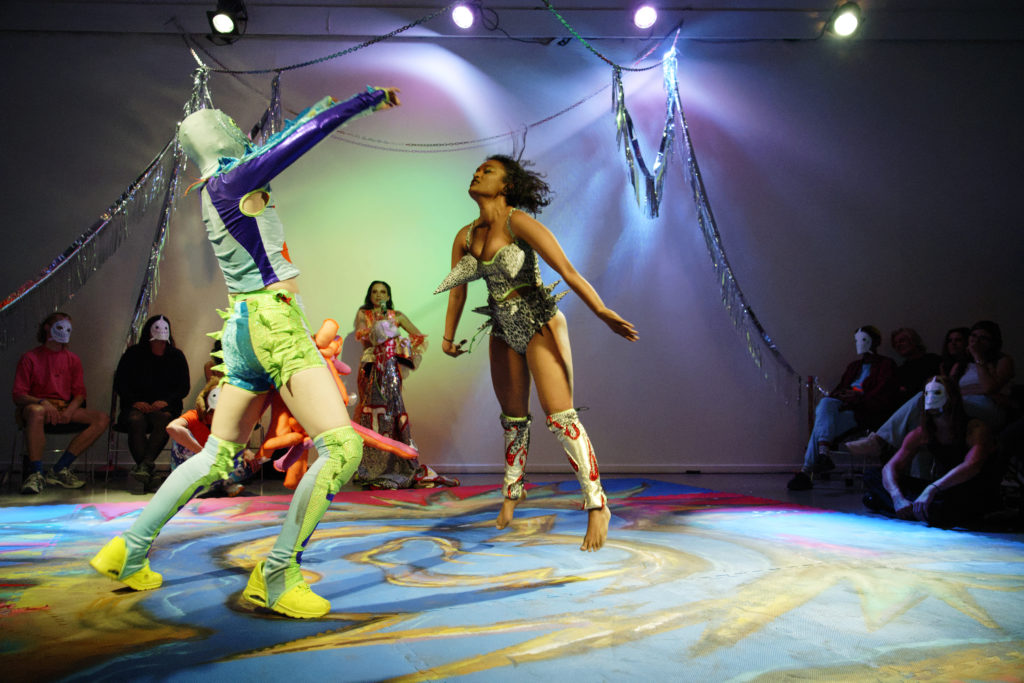
Note: The project The Goldfish Bleeding in a Sea of Sharks – Wrestling Club is a series of artistic actions that reflect and react to the current impacts of Neoliberalism and Neoliberal ideology in the art market, changing and conditioning the social role of art marking. The project is composed of a performance piece and a parallel research programme involving a team of artists engaged in thinking of potential political intersections to either reform or destroy the neoliberal art market as a major totem of white supremacy, heteropartriacalism and colonial domination. The motto of the piece is the Lucha Libre, a Latin American form of wrestling where social characters can fight. In the show, the artists will fight against each other, for the price of having the most successful business model of the world, repeating neoliberal lies such as: meritocracy, talent and fair curatorial processes.
Thais Di Marco: Well, I’m working mainly on two different big projects. One is The Goldfish Bleeding in a Sea of Sharks and what’s nice about this project is that for me, it is an achievement in the [arts] working field.
I work in the Netherlands at the moment and here the system works pretty much as if the public resources and theater houses were talent agencies. For a couple of years now I’ve been trying to integrate the idea that the performance as a product is not enough to embrace all the debates. So the fact that the The Goldfish Bleeding in a Sea of Sharks has the paneling club, the partying club, the debating club, the researching club, the traveling club, so these different actions for me are important. The fact that I got resources and nice partners to work with…[This is] something that’s not the established form of artistic projects in my context, so for me, this is currently the main achievement of the work I’m doing now.
Another project I’m working with is called How to. A Score and is proposed and directed by Mia Habib. It is a project-based in Norway, but that works with five different directors from different cities in the world. I’m really diving into production mode at the moment and how to dispute the social roles of art that I make.
ASH: I’m really interested in what you are referencing here because when I was looking at the Goldfish project, I looked at WORM’s programming and saw that there were different kinds of publics involved throughout the programme, which is really an extension of the artwork. Is that something you’ve done before? Or do you always think of the public element in your practice (or try to) whenever you’re given the opportunity?
TDM: I think theater or performing arts as such comes from the legacy of public assembly. So, theater was born into a public arena. And so for me, it’s historically impossible to do in another way.
ASH: That’s a good segue into the first question I posed to you in writing and to which you also responded with thinking about legacies.
I really liked the description on your website of the themes that you’re exploring through your work, which you describe as “choreographies of power that perform algorithmic maintenance of the status quo through our bodies”. That really resonated with me because I think for a long time, I’ve been thinking about how our bodies perform choreographies of systemic structures, and how they do that without us even noticing, but also how you can intervene with alternate choreographies, which is what I sometimes view activist work being at the best of times: an embodied practice. It’s your body interfering, intervening with a resisting choreography to the one that’s been taught to you. So, my question to you was, do you think activism can be a kind of embodied performance or is it something else entirely?
TDM: When I left Brazil, I wasn’t familiar with the term activism at all. Art practices were an inherent part of the process of Latin American countries democratizing after dictatorships and literally all the artists were politically engaged in one way or another. I deeply respect the work of activists, but I don’t think I carry this legacy and that is not the trajectory of my body or art practice. When I’m working in Europe, I’m often asked if I’m an activist or directly placed as such, about this with my experience here I would say:
– “Activism” is unfortunately a term, in my experience, used often by curators to distinguish white artists from immigrant artists. Often white European artists have access to resources and support by art institutions for producing any form of abstraction, minimalism, apolitical work to express their notions of “freedom”, while for those who have a racialized body any movement is perceived and read as “political” and therefore lose their status as “art”. In this way, curators and decision-makers don’t need to be morally busy with programming immigrant artists or diasporic people, or reflecting about the political stands of the art that they like to consume.
– The fact that any work or artist that show their political stands is called “activism” to me shows how the art market in Europe is an experiment of hiding the actual ideology behind the works. Also prevents people in power to actually show what they believe and what is their political project regarding the cultural politics they practice.
– The fact that everything that is perceived as art, needs to try hiding its political stands to be booked, brings an endemic state of dumbness in the art production, where nothing can be spoken or debated, otherwise it loses its value. It is also a problem that contributes to that, the fact that right-wing governments have been operating a radical neoliberal cultural politics, which is historically known by generating labor precarization, mental health conditions aggravation, generalized fear on workers and substantial decrease in the quality of people’s works and organizations.
– Another question I find dangerous about it is the amount of artists I see with no political background, no community-based work and very privileged social positions calling themselves “activists”, claiming they represent thousands or even millions of people that they don’t know , branding themselves to have access to public resources for organizing short term events here and there. I find this very perverse while compared with lifelong journeys dedicated to community politics and actions of social transformation throughout the globe. I want to give value to the danger that many people assume while confronting daily the frontline of genocide, ethnocide and militarized states, constantly risking their own lives in the name of their ancestral legacy and in the futurities of the planet in opposition to branding and party organizing in hyper-neoliberal contexts. I call the second one: neoliberal activism.
To finish this question, I would like to say that for me doing activism is not different than doing any other form of politics, and I would like to honor the activist and parliamentary Mariele Franco, assassinated in Brazil by the militia after being at a small political gathering of black women. And to say that this is very different from working in the art market.
I’m afraid with this perspective, I can’t really answer the question about what activism is in relation to embodiment, but it sounds very interesting to me and I would love to hear more.
What I can add to this is that in my best works, I think I’ve been encountering [a practice of] teaching and coordinating. Coordinating art practices in social programs for the democratization of art and looking at how to look at power, from the perspective of oppressed people, a very important distinction! (laughs) From the perspective of those bodies, their conditions, and their whole life fighting for liberation, wanting it or not, how power is a performance. What is the performanitivity of power? Is power also a form of art?
ASH: I’m going to go to the second question – I see your work as something that sits between activist actions and art actions, and I’m interested in the idea of Artistic Protest that you reference in your work Blood Shower. This makes me think of art spaces as spaces of immunity (maybe more so in the ‘global north’) where otherwise criminalized actions can happen. What do you find most generative about working in this space? What do you find challenging or maybe even contradictory about it?
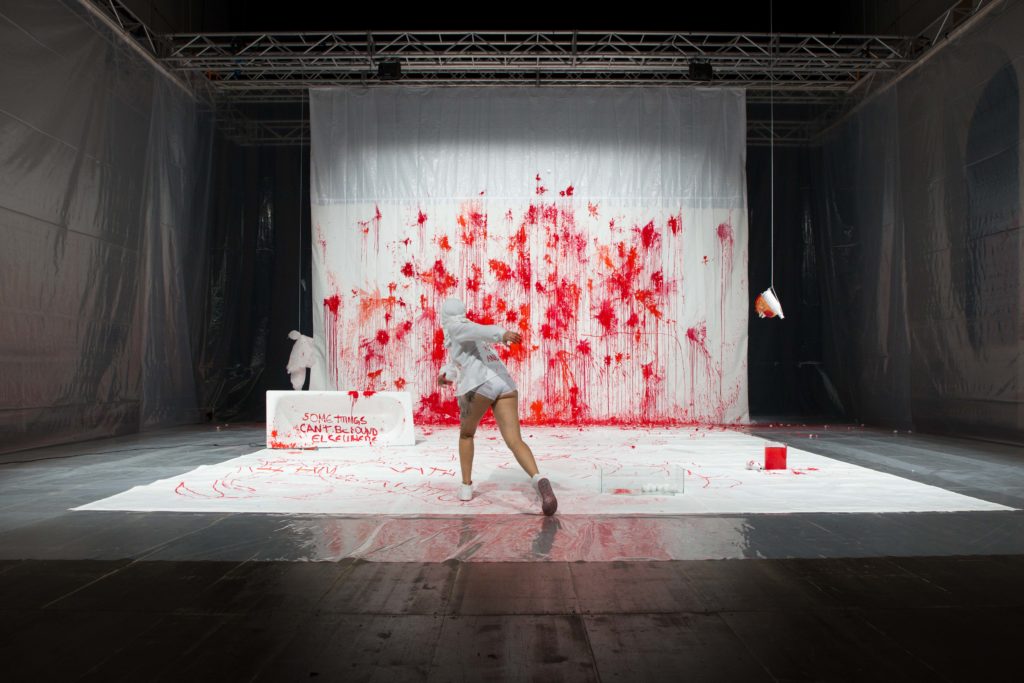
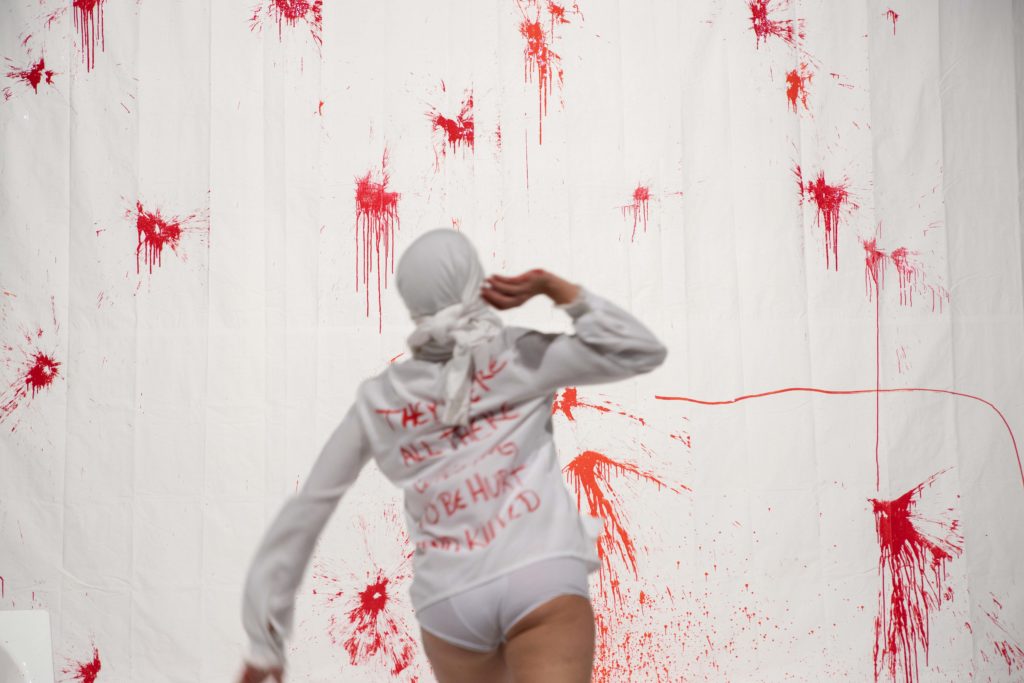
Note: Watch a recording of Blood Shower here.
TDM: I think your question expresses indeed one of the subjects I work with in Blood Shower, the fact that sculpture and painting in political street demonstrations are labeled as vandalism and not as an art action. I try working with live painting in this performance, a technique of painting vastly used in public demonstrations and try to create some sense of disorientation on the binarity vandalism/commodity art.
Indeed, the notion of immunity applies very well here and it is a very interesting reflection. I think it is also enriching to give class, gender, race and nationality to this immunity as the art market treats artists not the same and is highly discriminatory, especially regarding the aesthetic they want to work with.
I don’t find it generative working in the art market in Europe, and [any other market], as all of them copy the European system to a degree. I find the production system, the European networks, and the relation to the politicians very corrupted. You see white rich curators sitting in positions in public art institutions as long as they want, making very untransparent selection processes and no way for the whole of the society to verify their work. They are often known to each other and live from one festival to the next while playing and consuming the suffering of the artists in pieces that they feel entitled by their unjustified privilege to judge “good or bad”, “urgent or not”, “relevant or not”. You see sterile business models replacing the space of public debate and thinking development and the potential for building futures that we might want to leave in being silenced. You see the art schools giving no political education to their students and only establishing, by ostensive training, essentialist obsolete and unclear ideas of talent, merit, profile and other de-humanizing ideologies. You see the state budget going to pay workers of the art institutions while indiscriminately exploiting the artists. You see the church of neoliberalism, entrepreneurship, competition and egocentrism. To work in this field was the better choice I had to achieve some personal and community goals and I just hope I can make some form of contribution for my descendants.
I think this question ends up [asking] if it’s contradictory or not [to create political work], and for me, it’s almost a spiritual question (laughs), because I guess I would be trying to make structural contributions with whatever profession I would end up doing. Like, why are we doing what we’re doing or why are we still making art? It’s something that for me, has to do with your ancestors and your descendants. What is your role in your own [community]?
And then I understand that when you have a broken identities or hidden identities, like white supremacy, that’s a hidden identity, or you come from legacies of denial […], then it’s harder to understand the journey of your life as something that is not only about you.
ASH: That’s really interesting, particularly because of your reference to the legacies you carry in your body. That makes me think of when we see white people make art, specifically for example white British people, the access to their legacies is so broken. Watching them struggle to pull from other legacies can be painful, as an audience member, but also as an artist. Speaking to this idea of like the neoliberal market of activism, it’s like they’re buying something off the shelf and they’re putting it in their practice to make it meaningful [I see this happen a lot with ‘climate/eco’ art for example].
This question also made me think of the art sector in the west where I can probably get away with saying different things as part of a minority group, which is different from when I am functioning in a Latin American context, where my body means something totally different in institutions [as a mestiza Latina woman, my presence is no longer radical but upholds existing colourism and colonial legacies]. And so, I think having to balance those two things is something I’m always thinking about, and that’s something that they (white artists functioning in a western market) never have to think about.
What has your experience been like bringing your work across borders? Especially as Latin American people, our bodies can mean different things depending on the contexts we exist in.
TDM: Well, I try first to keep the dream – I’m Roma descendant. My ancestors were Roma people, and I think there is something there that has no borders, this concept simply doesn’t exist much. So, I try to always remember that I am on my planet moving my body. That’s it. There is no borders… as a belief, as a utopia let’s say. But indeed, when I’m dealing with different, representations, and different privileges I have in different places, I try to include the positionality of my body and the body of others in relation to the context that I am in. So, I would say my approach to power is site-specific. I try to not export or to transplant the research that was done in one place to another. I think that’s just not possible.
ASH: You’ve worked directly with feminist and revolutionary groups, can you tell me more about what this has been like for you as an artist? How has your work engaged with these political spaces? For example, in your workGuerrilha Coreográfica?
TDM: I have never not been in social movements. So, to be out of social organization was not possible. I was born in a country where every three minutes a person assigned as female is murdered. So, when you’re facing this situation, it’s very clear why you need to organize, if you were assigned in the same way. I had to organize to survive. So that was really tied to the environment l was in, to people I feel comfortable with. I started making art in social movements, as social projects and not necessarily as political activities
ASH: So now when you enter a new political space, like when you did with the Zapatistas for example, how do you enter? As a comrade who is also an artist? Or do you come as an artist who wants to interpret their politics? I’m interested in how you make that bridge.
TDM: I try to only go in places that I am invited to, often to learn. So my position is just to get in touch, to exchange, to learn a lot, to observe a lot, when I am invited to do so. The Zapatistas organize a couple of events for artists, [in the one I went to] in 2016 Comparte por La Humanidad they invited artists from around the world that were fighting for liberation. They have a long history of establishing some form of political tourism. That was a term I heard a lot. And then when you go, organizations that help people participate in the Escuela Estrella they use the term “human shields”. So, I think often when I go to other political places, I try to understand their frame. What is my body invited to? And then I figure out whether I agree or not, from the moment that I start to understand what it is. But all of that requires time, curiosity, willingness to learn, to listen, to observe, courage to question, and then I think those skills are more like diplomatic work. I’m really inspired by my Candomblé community, and how they have this culture of sending ambassadors for parties and for public events. I try to be more based on how a person from the Candomblé community would go to the other, instead of only practicing tourism. Although sometimes it’s not possible to divide.
In Guerrilha Coreográfica we went to participate in this artistic gathering in Chiapas, and later we got inspired by [that] and worked on how artistic practice could operate an actual concrete role into keeping the struggle for territory. The [artists involved] didn’t start this thinking there, we were already embedded in social programs of teaching in territories with high rates of state genocides, and we all also felt very curious about the artistic language, that the Zapatistas use to express themselves politically through art, poetry, paintings etc […] After this moment of inspiration, we came back to our working groups [in Brazil] and we worked at Brasilândia cultural center with local activists, politicians, and artists trying to share this question. We mapped where and how we use art and thought about whether the art that we make is already helping us to guarantee those rights or not. We then created some artistic actions based on that.
ASH: What have you most taken from this process?
TDM: There are plenty but the one that’s most influenced me in the following years was the fact that I saw the Zapatistas being invited for different panels, debates and interviews that always had a proposal or a frame, like: Today the Zapatistas are going to talk about Agriculture, and then you would go to the event and they would take the microphone and say whatever was important that day. And this was never related to the framework that was announced. So that made me understand deeply – ah, okay it’s just a platform. So, I started changing the names of my performances. Because I understood that the name of the performance is something that will go to the media, to social media, it is something that will have visibility, the content of my performance much less so. I kind of disconnected the name of my performances with the actual happening, and this made me understand how marketing could be a place for me to make political disruptions. So then I arrived years later to a work that’s called# fucktheartmarket, and this name was placed in a lot of newspapers and when people would say to me: what does this actually have to do with the piece? I would say: really nothing. Still there was a possibility of spreading this hashtag and getting it published in official media, that statement is something that is under seen and that artists are not yet advocating for – the destruction of the art market.
ASH: I like the idea of disconnecting the name from the performance because it feels contradictory to how artistic practice pushes you to document and communicate about your work. I also think it overlaps with some activist practices that ask similar questions on how we can hack the public system, which I love.
TDM: Talking about naming, maybe I can talk about the naming of The Goldfish Bleeding in a Sea of Sharks? The name comes from both my fathers, since I was very young, they encouraged me as a daughter of Yansã to be very brave, to be very courageous, to go to the front line, and that was something that was praised about me before I could decide anything myself. When I started to grow older, to become a child and then a teenager, they started to think: wow- maybe that was too much encouragement! Because this person is always challenging bigger powers than themselves, bigger than what they actually have the capacity to confront. In Brazil, there is a saying to warn someone (which I always received): Don’t act as the goldfish bleeding in a sea of sharks.
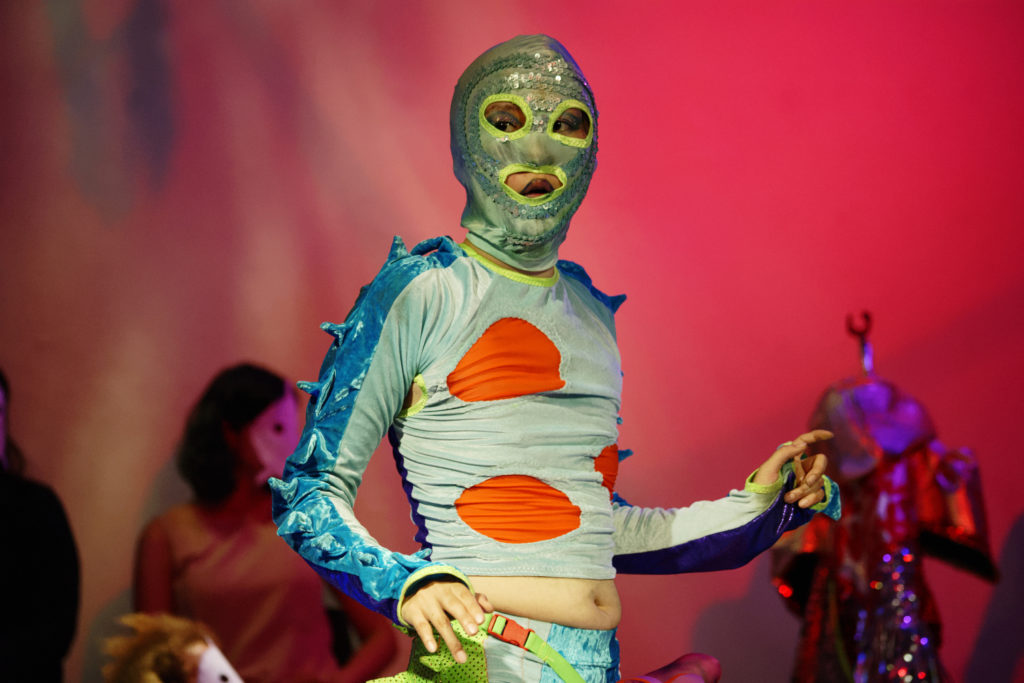
In my head, [that’s connected to the work because] the shark is the metaphor for neoliberalism. So, I tried to make a couple of actions by inviting people to talk about neoliberalism through different lenses, specifically what is neoliberalism in the art market and how do we recognize it? What is the political project behind it? How is this impacting the possibility or the impossibility of organizing collectively among artists? How is this affecting the individual life of artists? And how is this changing the conditions of what type of art we like? So I tried to de-mystify neoliberal ideology that has been traveling through the artist, without them even knowing. For example, through the concepts of talent, merit, profile and through patronizing and corrupted structures. Why are the artists fighting against each other so much? I think it’s a demobilizing cultural politics that’s going on for a political project.
ASH: You use Lucha Libre in the performance, when and why did you start using it?
TDM: Well, I consumed the Lucha Libre a lot when I was a child and later, I was always very attracted because I grew up in political leftist movements and experiments. […] And what I found fascinating about Lucha Libre when I went to Mexico to study with the professor ‘El Gladeador’ in Escuela Arena Mexico (the biggest school of Lucha Libre), was how there are all these layers that co-exist – it’s so post-colonial for me (laughs)! It’s entertainment, it’s art, it’s wresting and it’s carrying the legacies of ancestors but the cosmology is being told through entertainment, it’s the favorite type of art of the Narcos, it’s a mixture of all the social classes, the violence is not real but it’s morally real. The wrestlers, they can actually die and they die a lot when they are performing it, but not from the punches. So, I have a lot of fascinations about Lucha Libre as a post-colonial mess.
ASH: When I watched the performance, I was really interested in the introduction. You spend a really long time hyping up the audience. I was like, this is fantastic because it replicates this idea of post-colonial aesthetics as an aesthetics of “too much”. I know that you were in Amsterdam performing it at FLAM (performance festival), and I just kept thinking about the context: Dutch people coming into a room, being exposed to the costumes, to the lights, to the dancing, to the body moving in people’s faces and how this aesthetic of EXCESS is usually seen as kind of like… what’s the word? In Spanish you say ‘cutre’ or tacky…it’s not perceived as refined. I’m thinking about performances of power also in relation to the audience, and the space you were performing in. It was always going to land that way in that particular context because the audience can’t leave the gallery and go to a mercado (Spanish for outdoor market) or something, this performance would be super different if it was in Latin America where it would have been equally chaotic outside the gallery as it was in your performance. Bringing that aesthetic to a northern European audience and asking them to look at the mess that [postcoloniality] is, it’s great…
I’m curious, would you ever do this performance in Mexico, or would you feel the need to change it a little bit?
TDM: When I was in Mexico, I think a lot of Mexican artists either didn’t understand why I was studying at the Escuela or they said that everybody had already “done this” (Lucha Libre). But that’s not the point of being in relationship to Lucha Libre, I think for me it’s very important that no one cares what I’m doing (but also very interesting that no one points me out as cultural appropriation because I’m from Brazil, not from Mexico). No one really cares at this point [how you use Lucha Libre] anymore. I think the tradition is literally already so post-apocalyptic, that everyone is welcome to try the medium. And ultimately, I am doing my own version: a wrestling show made for artists and by artists.
ASH: It’s perfect because you’re allowed to create characters who aren’t people, they’re ideas and stereotypes, and you get to re-stage social dynamics in a way that is hyper obvious. You’re using the methodology of Lucha Libre as an art practice to create new social commentary – it’s amazing!
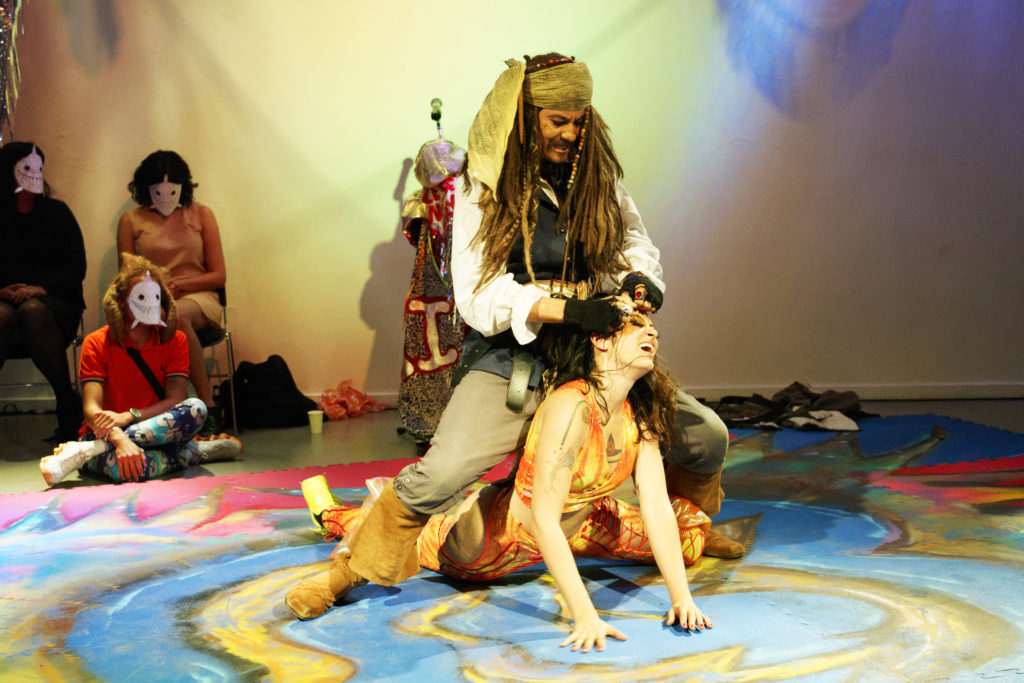
The Goldfish Bleeding in a Sea of Sharks – Wrestling Club had it’s premiere in Amsterdam in May at FLAM and will be performed at WORM, in Rotterdam in September 2022. To find out more about the project see the project site here.
Follow the project on Instagram: @thegoldfishbleeding and the director Thais Di Marco @gunpowder.on.fire
Linking to the themes of the interview in regard to neoliberal and extractivist curatorial practices, Thais has shared a text with PB from their group The Octopus Artists Against Necropower and Neoliberalism – we recommend you read their letter with demands to curators (and the sector)here.
Thais Di Marco (she/they) is a theater director and choreographer specialized in art production in contexts under conditions of violence with 15 years of practice in performing arts and cultural politics. Thais was teacher during 6 years, of projects at Brasiliândia Cultural Center, the only theater at the neighbourhood with one of the highest rates of state genocide in Latin America. Later, she shared her research in different contexts such as Ocupa Ouvidor, the biggest cultural squat of the Americas, in the festival Les Echos de Lobozunkpá in West Africa and at the space Bongah in Iran, on power issues and worked in social programs for democratization of the arts. Thais studied Lucha Libre at Escuela Arena México. They currently work with partners to either reform, or destroy the art market as a totem of neoliberalism, corruption, cosmological violence, heteropatriarchalism and white supremacy. Since she started working in The Netherlands, Thais was sponsored by AFK for the project Dr. Stranger Folks in partnership with the artist Ehsan Fardjadnya and the Prof. Judit Kende, and did Spreekuur modality for a duet piece. Thais was co-choreographer of the piece Omni Toxica in partnership with Paula Chaves, supported by Veem House for Performance and Theater Rotterdam, and was resident artist of New Adventures by Dansmakers, Nineties Lab by Nineties Productions, among others. She has been student external adviser for SNDO alumni students Karina Vilalfan and Raoni Saleh and for Das Theater alumni Rodrigo Batista and Mariana Senne. In the European context, Thais held projects with partners at Beursschouwburg – Brussels, Centrale Fies – Italy and Ballhaus Ost in Berlin and started the social movement for artists: The Octopus Artists Against Necropower and Neoliberalism.
Thais or Kaloyá, is Roma diasporic descendent and was born in an Afro-Brazilian community of Candomblé – in Brazil – where she holds the title of young xamã or Egbomi. Those communities integrate a huge range of African, Afro-latinas and Indigenous diasporic secret societies ruled by ancestors and carrying the legacy of quilombola struggle. Her first artistic education in contemporary art was within social projects led by artists to think how art could play a central role for democracy in countries under conditions of extreme violence. In their personal work, they present provocative, sensual, engaged and humorous art. https://linktr.ee/thaisdimarco
